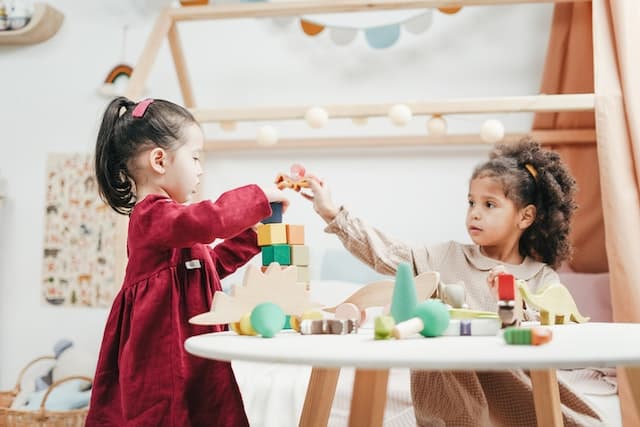Time-out is a common disciplinary technique used by parents and caregivers to help young children learn appropriate behavior. However, many parents are unsure how to implement time-out effectively for their 2-year-olds.
Understanding the basics of time-out and when and why it is necessary can help parents set up a successful time-out spot and implement the technique in a way that promotes positive behavior.
When used correctly, time-out can be an effective tool for teaching children to manage their behavior and emotions.
However, it is important to use time-out sparingly and only when necessary. Parents should also be aware of the potential negative effects of time-out, such as feelings of isolation and rejection, and consider alternatives when appropriate.
By setting up a time-out spot and implementing time-outs consistently and calmly, parents can help their 2-year-olds learn appropriate behavior and manage their emotions.
Key Takeaways
- Time-out can be an effective tool for teaching children to manage their behavior and emotions when used correctly.
- Parents should use time-out sparingly and consider alternatives when appropriate.
- By setting up a time-out spot and implementing time-outs consistently and calmly, parents can help their 2-year-olds learn appropriate behavior and manage their emotions.
Understanding Time-Out for a 2-Year-Old
Time-out is a common discipline technique used by parents and caregivers to manage a child’s behavior. It involves removing the child from the situation or activity that is causing the behavior and placing them in a designated area for a short period of time.
The goal of time-out is to give the child a chance to calm down and reflect on their behavior.
For a 2-year-old, time-out can be an effective way to teach them about appropriate behavior. At this age, children are learning to express themselves and test boundaries, which can lead to challenging behavior.
Time-out can help them understand that certain behaviors are not acceptable and provide them with an opportunity to learn self-regulation skills.
When using time-out with a 2-year-old, it’s important to keep a few things in mind. First, time-out should be brief, typically no longer than 2-3 minutes. Second, it’s important to use a designated area that is safe and free from distractions. This could be a chair or a designated spot on the floor.
During time-out, it’s important to remain calm and neutral. Avoid engaging with the child or discussing their behavior. After the time-out period is over, it’s important to talk with the child in a calm and positive manner about what behavior is expected in the future.
It’s important to note that time-out should not be used as the sole discipline technique. Positive reinforcement and praise for good behavior is also important for a child’s development.
Additionally, if a child’s behavior continues to be a challenge, it may be helpful to seek guidance from a pediatrician or child development specialist.
When and Why Time-Outs are Necessary
Time-outs are a popular discipline technique used by parents and caregivers to help young children learn to regulate their behavior. They are typically used for children between the ages of 2 and 5, and can be effective in teaching children that there are consequences for misbehavior.
Time-outs are necessary when a child exhibits a behavior that is unacceptable or dangerous. For example, if a child hits or bites another child, time-out can be an appropriate consequence.
Time-outs can also be used when a child is engaging in behavior that is disruptive or disrespectful, such as throwing toys or refusing to follow directions.
It is important to remember that time-outs are not punishment, but rather a consequence for inappropriate behavior. The goal of a time-out is to give the child a chance to calm down and reflect on their behavior, so that they can learn to make better choices in the future.
When using time-outs, it is important to set clear limits and expectations for behavior. Children need to understand what is expected of them, and what the consequences will be if they do not follow the rules.
It is also important to be consistent in enforcing the rules, so that children understand that misbehavior will always result in a time-out.
While time-outs can be an effective discipline technique, it is important to remember that they should not be used as a substitute for positive reinforcement. Children need to be praised and rewarded for good behavior, in addition to being disciplined for misbehavior.
In summary, time-outs are a necessary tool in teaching young children to regulate their behavior. They should be used when a child exhibits inappropriate or dangerous behavior, and should be accompanied by clear limits and expectations for behavior.
While time-outs can be effective, they should be used in conjunction with positive reinforcement to help children learn to make good choices.
Setting Up a Time-Out Spot
When it comes to setting up a time-out spot for a 2-year-old, there are a few things to consider. First and foremost, the spot should be a designated area where the child can go to calm down and reflect on their behavior.
This area should be free from distractions and breakables, and ideally, it should be in a quiet location.
One common option for a time-out spot is a chair. This can be a time-out chair or a naughty chair, but it should be a designated chair that the child knows is specifically for time-outs. The chair should be placed in a quiet location, away from any distractions or breakables.
Another option for a time-out spot is the bottom step of a staircase. This can be a good option if the child is having a hard time sitting still in a chair. The bottom step should be free from any objects or hazards that could cause the child to trip or fall.
When setting up a time-out spot, it’s important to make sure that the child understands the purpose of the spot. This can be done by explaining to them that it’s a place to go when they need to calm down and think about their behavior.
It’s also important to be consistent with the use of the time-out spot, so that the child knows what to expect when they misbehave.
Overall, setting up a time-out spot for a 2-year-old requires some thought and planning. By creating a designated area that is free from distractions and breakables, and by being consistent with its use, parents can help their child learn to regulate their behavior and emotions.
Implementing Time-Outs
When it comes to disciplining a 2-year-old, time-outs can be an effective tool for parents to use. It is important to note that time-outs should be implemented in a way that is consistent and fair to the child.
To begin, parents should establish clear rules for their child to follow. This can include rules such as no hitting, no throwing objects, or no biting. When a child breaks one of these rules, a warning should be given before a time-out is implemented.
During the time-out, it is important to set a timer for a specific duration, such as 2 minutes. The child should be placed in a designated area, such as a corner or a chair, and should remain there for the entire duration of the time-out.
If the child leaves the designated area or breaks another rule during the time-out, the timer should be restarted. This reinforces the idea that the time-out is a consequence for their actions.
Consistency is key when implementing time-outs. Parents should make sure to follow through with time-outs every time a rule is broken. This helps the child understand that their actions have consequences and reinforces the importance of following rules.
Overall, time-outs can be an effective tool for parents to use when disciplining their 2-year-old. By establishing clear rules, giving warnings, setting a timer, and being consistent, parents can help their child learn to control their behavior and make better choices.
Handling Emotional Outbursts During Time-Outs
Time-outs can be a challenging experience for both the child and the caregiver. It is not uncommon for a 2-year-old to have emotional outbursts during time-outs, such as yelling, crying, or even having a meltdown.
It is important to handle these emotional outbursts appropriately to ensure that the child understands the reason for the time-out and learns from the experience.
When a child has a burst of frustration during a time-out, it is important to remain calm and neutral. Caregivers should avoid getting upset or frustrated themselves, as this can escalate the situation.
Instead, they should acknowledge the child’s emotions and provide reassurance that they are there to help them calm down.
One effective way to handle emotional outbursts during a time-out is to encourage the child to take deep breaths. This can help them calm down and regulate their emotions. Caregivers can also provide a comforting object, such as a stuffed animal or blanket, to help the child feel more secure.
If the child continues to have a meltdown during the time-out, caregivers should remain calm and wait for the child to calm down before ending the time-out. It is important not to give in to the child’s demands or end the time-out prematurely, as this can send the message that the child’s behavior is acceptable.
In conclusion, handling emotional outbursts during time-outs can be a challenging experience. However, by remaining calm and neutral, encouraging deep breathing, and providing comfort objects, caregivers can help the child regulate their emotions and learn from the experience.
Alternatives to Traditional Time-Outs
While traditional time-outs have been a popular discipline method for young children, some parents and experts believe that there are more effective and positive ways to discipline a child.
Here are some alternatives to traditional time-outs that parents can consider:
Time-In
Instead of sending a child to a designated time-out area, parents can try a “time-in” approach. This involves staying with the child and providing comfort and support until they are ready to calm down and return to the activity.
This approach helps the child learn self-control and provides an opportunity for positive reinforcement.
Positive Reinforcement
Positive reinforcement is a method of discipline that focuses on rewarding good behavior instead of punishing bad behavior. This can be done through verbal praise, stickers, or small rewards. By focusing on positive behavior, children are more likely to repeat that behavior in the future.
Redirect
Redirecting a child’s behavior is another alternative to traditional time-outs. This involves distracting the child and redirecting their attention to another activity or behavior. For example, if a child is hitting a sibling, a parent can redirect their attention to a fun game or activity.
Formal Time-Out
While traditional time-outs can be harsh and ineffective, some experts believe that a formal time-out can be used as a last resort. This involves setting clear rules and consequences for misbehavior and providing a designated time-out area that is safe and free from distractions.
In conclusion, there are several alternatives to traditional time-outs that parents can consider when disciplining their child. By using positive reinforcement, redirecting behavior, and providing comfort and support, parents can help their child learn self-control and develop positive behavior patterns.
The Role of Toys and Activities in Time-Outs
Toys and activities can play an important role in time-outs for 2-year-olds. When a child is put in time-out, it is important to provide them with a safe and quiet space to calm down.
Having toys and activities available can help the child stay occupied and make the time-out a more positive experience.
When selecting toys for a time-out space, it is important to choose items that are calming and soothing. Soft toys, such as dolls or teddy bears, can be comforting to a child who is upset.
Toys that encourage exploration, such as blocks or puzzles, can also be helpful, as they can distract the child and help them focus on something other than their emotions.
It is important to note that the toys and activities should not be used as a reward for misbehavior. Rather, they should be seen as a tool to help the child calm down and regain control of their emotions.
In addition to toys, activities can also be helpful during a time-out. Quiet activities, such as coloring or reading, can help the child relax and focus their attention on something positive.
It is important to avoid activities that are too stimulating, such as playing video games or watching TV, as these can make it harder for the child to calm down.
Overall, toys and activities can be an important part of a successful time-out for a 2-year-old. By providing a safe and calming space, along with calming toys and activities, parents can help their child learn to manage their emotions in a positive way.
Guidance from Pediatricians on Time-Outs
Pediatricians often recommend time-outs as a discipline strategy for children, including 2-year-olds. The American Academy of Pediatrics (AAP) suggests that time-outs can be effective when used correctly.
According to the AAP, a time-out should be a brief period of time where the child is removed from the situation and placed in a designated area, such as a chair or corner.
The child should be told why they are being placed in time-out and how long they will be there. Typically, one minute per year of age is recommended, so a 2-year-old would have a two-minute time-out.
Pediatricians advise that time-outs should not be used as a punishment, but rather as a way to allow the child to calm down and reflect on their behavior. It is important to remain calm and not engage in an argument with the child during the time-out period.
It is also important to note that time-outs may not be effective for all children and situations. Pediatricians recommend that parents work with their child’s individual temperament and behavior to determine the most effective discipline strategies.
Additionally, time-outs should not be used as the sole discipline strategy, but rather as part of a larger plan that includes positive reinforcement and consistent consequences for misbehavior.
Overall, pediatricians suggest that time-outs can be a useful tool for parents when used correctly and in conjunction with other discipline strategies.
Parenting Strategies Beyond Time-Outs
While time-outs can be an effective tool for managing a two-year-old’s behavior, there are other parenting strategies that can also be helpful. These strategies can help parents build positive relationships with their children and promote healthy development.
Praise and Positive Reinforcement
One effective strategy is to use praise and positive reinforcement to encourage good behavior. Parents can offer specific and genuine praise when their child behaves well, such as saying “Great job sharing your toys with your friend!”
This can help reinforce positive behavior and encourage their child to continue behaving well.
Patience and Understanding
Another important strategy is to practice patience and understanding with a two-year-old. It’s important to remember that young children are still learning and developing, and may not always understand or follow the rules.
Instead of getting frustrated or angry, parents can try to approach challenging situations with empathy and understanding.
Avoiding Power Struggles
Parents can also try to avoid power struggles with their two-year-old. This can involve setting clear boundaries and expectations, but also being flexible and willing to negotiate when appropriate.
For example, if a child is refusing to put on their shoes, a parent can offer choices such as “Do you want to wear your red shoes or your blue shoes today?”
Involving Older Children
If the family has older children, parents can also involve them in the process of managing their younger sibling’s behavior. This can help older children feel included and valued, while also teaching them important skills such as empathy and conflict resolution.
Considering the Child’s Age
It’s important for parents to consider their child’s age when implementing parenting strategies. Two-year-olds are still developing their language and social skills, and may not always understand complex instructions or reasoning.
Parents can try to use simple and clear language, and break tasks or instructions down into smaller steps.
Nonviolent Discipline
Finally, it’s important for parents to avoid using physical or violent discipline with their two-year-old. This can include spanking, hitting, or other forms of physical punishment.
Instead, parents can use nonviolent discipline strategies such as time-ins (where the child is guided to a calm and safe space), taking away privileges, or offering choices.
Overall, there are many effective parenting strategies beyond time-outs that can help manage a two-year-old’s behavior. By using praise, patience, clear boundaries, and nonviolent discipline, parents can build positive relationships with their children and promote healthy development.
Frequently Asked Questions
How long should time-out be for a 4-year-old?
For a 4-year-old, the recommended time-out duration is usually about 4 minutes. This is enough time for the child to calm down and reflect on their behavior.
How long should time-out be for a 5 year-old?
For a 5-year-old, the recommended time-out duration is usually about 5 minutes. This is enough time for the child to calm down and reflect on their behavior.
How long should a time-out be for a 7 year-old?
For a 7-year-old, the recommended time-out duration is usually about 7 minutes. This is enough time for the child to calm down and reflect on their behavior.
Where do you put a 2 year old in time-out?
For a 2-year-old, it is recommended to place them in a safe and quiet area, such as a playpen or a designated time-out spot. It is important to make sure that the area is free from distractions and that the child is within sight at all times.
How do you discipline a 2 year old?
When disciplining a 2-year-old, it is important to use positive reinforcement and redirect their behavior. Time-outs can be used as a last resort, but it is important to keep them brief and age-appropriate. Consistency and clear communication are key when disciplining a 2-year-old.
Why is my 2 year old acting out so much?
There can be many reasons why a 2-year-old is acting out, such as frustration, lack of attention, or a need for independence. It is important to identify the root cause of the behavior and address it appropriately.
Positive reinforcement and consistent discipline can also help reduce acting out behavior in a 2-year-old.
Here’s a quick video on How to Give Time-Outs

Iesha is a loving mother of 2 beautiful children. She’s an active parent who enjoys indoor and outdoor adventures with her family. Her mission is to share practical and realistic parenting advice to help the parenting community becoming stronger.



